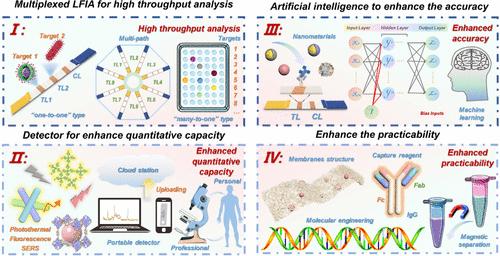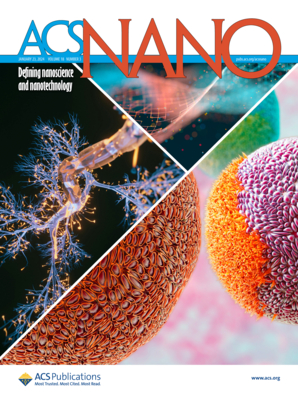Evaluation of the Multidimensional Enhanced Lateral Flow Immunoassay in Point-of-Care Nanosensors
IF 15.8
1区 材料科学
Q1 CHEMISTRY, MULTIDISCIPLINARY
引用次数: 0
Abstract
Point-of-care (POC) nanosensors with high screening efficiency show promise for user-friendly manipulation in the ever-increasing on-site analysis demand for illness diagnosis, environmental monitoring, and food safety. Currently, inspired by the merits of integrating advanced nanomaterials, molecular biology, machine learning, and artificial intelligence, lateral flow immunoassay (LFIA)-based POC nanosensors have been devoted to satisfying the commercial demands in terms of sensitivity, specificity, and practicality. Herein, we examine the use of multidimensional enhanced LFIA in various fields over the past two decades, focusing on introducing advanced nanomaterials to improve the acquisition capability of small order of magnitude targets through engineering transformations and emphasizing interdomain fusion to collaboratively address the inherent challenges in current commercial applications, such as multiplexing, development of detectors for quantitative analysis, more practical on-site monitoring, and sensitivity enhancement. Specifically, this comprehensive review encompasses the latest advances in comprehending LFIA with an alternative signal transduction pattern, aiming to achieve rapid, ultrasensitive, and “sample-to-answer” available options with progressive applications for POC nanosensors. In summary, through the cross-collaboration development of disciplines, LFIA has the potential to break the barriers toward commercialization and achieve laboratory-level POC nanosensors, thus leading to the emergence of the next generation of LFIA.

评估床旁纳米传感器中的多维增强侧流免疫分析法
在疾病诊断、环境监测和食品安全等日益增长的现场分析需求中,具有高筛选效率的护理点(POC)纳米传感器显示了方便用户操作的前景。目前,受先进纳米材料、分子生物学、机器学习和人工智能等优势的启发,基于侧向流免疫分析(LFIA)的 POC 纳米传感器已致力于满足灵敏度、特异性和实用性等方面的商业需求。在此,我们回顾了过去二十年来多维增强型侧向流免疫分析在各个领域的应用,重点介绍了先进的纳米材料,通过工程改造提高对小数量级目标的捕获能力,并强调跨领域融合,共同应对当前商业应用中的固有挑战,如复用、开发用于定量分析的检测器、更实用的现场监测以及提高灵敏度等。具体而言,本综述涵盖了在理解 LFIA 与另一种信号转导模式方面的最新进展,旨在实现快速、超灵敏和 "从样本到答案 "的可用选项,并逐步应用于 POC 纳米传感器。总之,通过学科交叉合作发展,LFIA 有可能打破商业化障碍,实现实验室级 POC 纳米传感器,从而引领下一代 LFIA 的出现。
本文章由计算机程序翻译,如有差异,请以英文原文为准。
求助全文
约1分钟内获得全文
求助全文
来源期刊

ACS Nano
工程技术-材料科学:综合
CiteScore
26.00
自引率
4.10%
发文量
1627
审稿时长
1.7 months
期刊介绍:
ACS Nano, published monthly, serves as an international forum for comprehensive articles on nanoscience and nanotechnology research at the intersections of chemistry, biology, materials science, physics, and engineering. The journal fosters communication among scientists in these communities, facilitating collaboration, new research opportunities, and advancements through discoveries. ACS Nano covers synthesis, assembly, characterization, theory, and simulation of nanostructures, nanobiotechnology, nanofabrication, methods and tools for nanoscience and nanotechnology, and self- and directed-assembly. Alongside original research articles, it offers thorough reviews, perspectives on cutting-edge research, and discussions envisioning the future of nanoscience and nanotechnology.
 求助内容:
求助内容: 应助结果提醒方式:
应助结果提醒方式:


